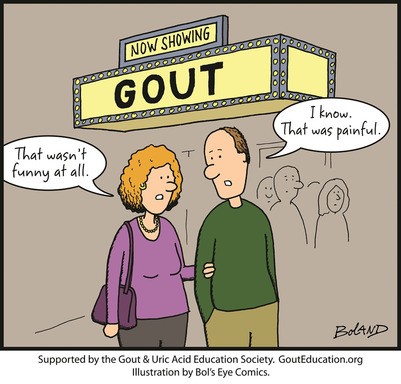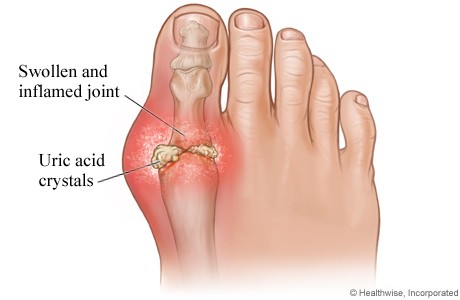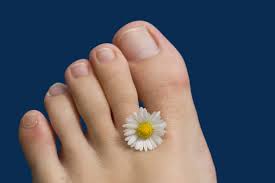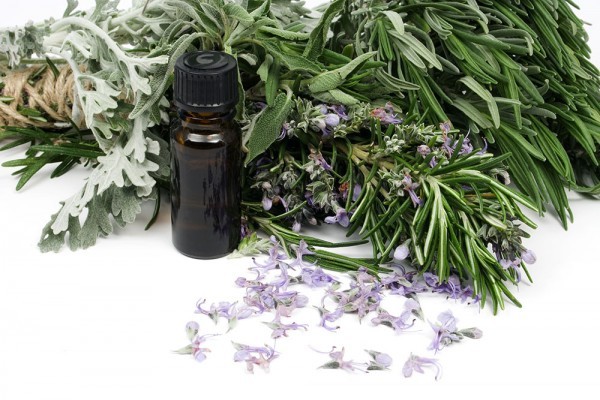Gout – Not Just ‘The Affliction of Kings’
Causes
- Basic cause: Gout is caused by the build-up of elevated levels of uric acid, a waste product created when the body breaks down chemicals in the cells called purines. It is naturally excreted from the body via the kidneys, in the blood. In Gout, the high levels can either be caused by producing too much uric acid or by the kidneys being unable to excrete enough uric acid with urination. Over time levels can become so high that it forms crystals of sodium urate & can deposit in the joints, tissues, tendons or ligaments. This can build up, undetected, over a number of years.
- Diet (c. 12% of cases)
- excessive consumption of alcohol – beer (high in purine), spirits then wine
- meat, seafood & fructose-sweetened drinks, yeast/beef extract – high levels of purine.
- Popular beliefs now proved untrue: to avoid purine-rich veg & legumes (beans, spinach, peas, lentils) & high levels of protein. It is fine to eat these kinds of purine-rich foods.
- Age: tends to be in older people but can affect younger
- Sex: 3-4 times more likely in men, younger women are more protected by the hormones of the reproductive cycle so more likely post-menopausal in women. 1 in 7 men over 30, 1 in 16 women over 60
- Obesity, high levels of fat & cholesterol
- High Blood Pressure
- Diabetes
- Surgery
- Physical trauma
- Genetic/hereditary links: 1 in 5 sufferers have it in their immediate family
- Genetic disorders
- Medical conditions e.g. kidney disfunction
- Medication
- Osteoarthritis: particularly in joints of extremities e.g. toes & fingers
Symptoms
Recurrent acute attacks:
- Severe & sudden attack of pain – developing quickly, usually at night, over 6-24 hours, lasting 3-10 days. It tends to then disappear/improve but further attacks are likely to occur.
- Pain is extreme, with tenderness on palpation/unable to touch, even the lightest of touches. There is often swelling, the skin often appears red & shiny often with skin flaking as an attack subsides.
- The crystals build at the joints & can spill over from the cartilage into the tissues & cause inflammation of the synovium – hot, painful, swollen joints. Usually base of big toe (70% of first attacks), although can also affect fingers, wrists, elbows, ankles, knees etc. but mainly the extremities. If left untreated it tends to spread.
These in turn can lead to:
- Inflammatory Gouty Arthritis – 2nd most common type of Arthritis after OA
- Repetition: Attacks will be 62% likely to repeat within a year & reoccur any time, without treatment attacks are likely to become more frequent.
- Tophi: lumps of uric acid crystals which can build up to form lumps under the skin, these can form any time between 3-40 years, usually over 10 years.
- Tophi can sometimes break through the skin appearing as chalky white or yellowish nodules, usually at joints, sometimes in the kidneys or nose
- can then limit joint mobility
- can cause destruction of the cartilage & bones
- can lead to further disability & permanent damage, but only usually after many years
- RCG (Refractory Chronic Gout): if left untreated or treatment is unsuccessful RCG can develop
- Kidney Stones: formation of stones from minerals in the kidneys, in this case uric acid
- Uric acid nephropathy: decreasing kidney function due to high levels of uric acid (kidneys also help to lower levels of uric acid so there is a catch-22/feedback loop here)
- Depression/anxiety: linked to the condition due the its difficult nature, pain, lack of mobility etc
Treatments
- Good prognosis: for most sufferers
- Self-help:
- avoid weight-bearing
- rest
- elevate
- Increasing consumption: of water, vitamin C, coffee, dairy produce
- Increasing exercise: e.g. swimming as cushions joints, yoga
- Gout medication: to decrease levels of uric acid or increase the elimination of uric acid through the kidneys
- NSAID Painkillers: in first instance (contra: kidney issues, warfarin, Blood Pressure)
- Colchicine: developed from Autumn Crocus, reduces ability of crystals to inflame synovium (has side effects so low dosage)
- Corticosteroids: in severe cases, for thse unresponsive to above (side effects so short-term, low dosage; contra: kidney, liver, HF, diabetes, glaucoma)
- Cold Water: placing the affected area in cold water will reduce swelling as well as pain. When you have gout, do not use ice directly on the skin; it can damage the skin & make your condition worse.
- Immerse the inflamed, swollen joint in cold water for 10 to 15 minutes. Repeat the process several times a day.
- You can use an ice pack for about 15 minutes, but wrap it in a towel before placing it on the affected area. Do this twice a day. Avoid excess use of ice packs because it can lead to crystallization of uric acid.
- Preventatives
- Allopurinol: inhibits the enzyme which turns purines into uric acid. Low dose is increased gradually to dissolve all crystals (contra: severe kidney as broken down by kidneys)
- Febuxostat: same method but broken down by liver so more suitable for kidney (contra: liver, HF)
- Natural Remedies: there a huge range of options & there is a lot of information out there! Unfortunately this blog would become an essay if I listed them all – however, I have done some research so please contact me for more information. ALWAYS check with your doctor first about your specific medication & conditions to check there are no contraindications. Advice & natural remedies are available at good health stores & herbalists:
http://www.nealsyardremedies.com/remedies/
http://www.baldwins.co.uk
http://www.hollandandbarrett.com
Aromatherapy
Essential Oils (those in green are the most indicated)
- Angelica Root, Atlas Cedarwood, Basil, Benzoin, Carrot Seed, Cypress, Frankincense, German Chamomile (esp if inflammation is bad) (Matricaria recutita – not Roman Chamomile Anthemis nobilis), Grapefruit, Juniperberry, Lavender, Lavandin, Lemon, Sweet Orange, Pine, Plai, Rosemary, Rosemary verbenone, Thyme linalool
Application
- Massage: on the affected area can be helpful, but is not always possible due to the pain upon touching the area & tenderness experienced.
- Foot Baths: warm or cool dependant upon preference & toleration (see below)
- Cold Compress: to affected area (see below)
Blends
- Juniperberry alone or with Cypress
- Foot bath – warm: add 4-6 drops of one oil or 3 of each to a washing-up bowl of warm to luke-warm water, soak the affected area
- Foot bath – cool: add 4-6 drops of one oil or 3 of each to a washing-up bowl of cool water, soak the affected area
- Cold Compress: add 4-6 drops of one oil or 3 of each to a small bowl of cold water, add ice cubes, dip in a cotton/linen cloth, bandage or muslin, wring out & place on the affected area
- Basil
- Cold compress: add 4-6 drops of one oil or 3 of each to a small bowl of cold water, add ice cubes, dip in a cotton/linen cloth, bandage or muslin, wring out & place on the affected area
- Massage: Rub diluted essential oil into affected area – use half number of drops to carrier oil e.g. 5 drops of essential oil to 10 mls of Sunflower/Sweet Almond oil
- Rosemary & Juniperberry (deposits)
- Rosemary & Lemon (deposits).
- Safety caution: Lemon – phototoxic, not above 20%, 20 drops in 25mls of carrier oil
- Rosemary, Atlas Cedarwood & Pine
- Safety caution: Pine – dermal senstiser, not above 2%, 10 drops in 25mls of carrier oil
- Carrot Seed, Angelica Root & Sweet Orange (topical use for flare-ups)
- Safety caution: Angelica Root – phototoxic, not above 0.78%, 4 drops in 25mls of carrier oil
- German Chamomile, Plai & Lavandin (for inflammed joints)
- Juniperberry, Angelica Root & Grapefruit
- Safety caution: Angelica Root – phototoxic, not above 0.78%, 4 drops in 25mls of carrier oil; Grapefruit – Phototoxic, not above 4%, 20 drops in 25mls of carrier oil
- Benzoin
- Thyme linalool
I was asked by a client to investigate how aromatherapy & massage can support sufferers of Gout. I found that it is a surprisingly common condition with many different natural treatments which can help to bring support, relief & be used effectively alongside conventional allopathic medicine. ALWAYS check with your doctor first about your specific medication & conditions to check there are no contraindications




